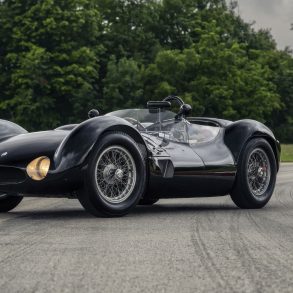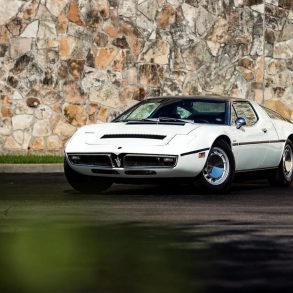Maserati 250 F
Car: Maserati 250 F / Engine: 6-Cylinder In-line / Maker: Maserati / Bore X Stroke: 84 mm X 75 mm / Year: 1957 / Capacity: 2,490 cc / Class: Formula 1 / Power: 270 bhp at 8,000 rpm / Wheelbase: 89.8 inches / Track: 51.2 inches Front, 49.2 inches Rear / Weight: 1477.1 lbs / Wheels: 15.0 x 4.0 / 16.0 5.5 Front & Rear
Maserati, founded by four brothers name Alfieri, Bindo, Ettore and Ernesto had been involved in motor racing since 1926. Based in Bologna they fought Bugatti, and Alfa Romeo for supremacy in Grand Prix Racing. In 1934 there world and that of racing in general was turned upside down with the entry of the German teams, Auto Union and Mercedes. Unable to compete on equal terms with the better financed Germans they found refuge in 1.5 litre Voiturette racing and Indianapolis. Their business was based on selling customer race cars and in order to promote their cars they had to win.
Voiturette racing was very popular and Maserati was able to sell a number of cars. But still the brothers were forced to sell to industrialist Adolfo Orsi. Their agreement allowed the brothers to remain associated with the company until 1947. In 1939 and 1940 a privately entered 3.0 litre Maserati 8CTF won Indianapolis. Meanwhile back in Italy the 1939 season was confined to cars with 1.5 liter engines. Except for falling victim to Mercedes’ surprise entry at Tripoli where the German team dominated the new Maserati 4 Cylinder In-line 4CL was able to win a few of the lesser races before the war put an end to racing.

In 1950 a World Championship for drivers was introduced. The championship would be decided based on the results of seven races: the British, Swiss, Monaco, Belgium, French and Italian Grand Prix and the Indianapolis 500. The latter was included in the hope that this would promote Grand Prix racing in the Americas but in reality the effects were minimal. Alfa Romeo returned to contest this new series with a team made up of pre-war drivers, Giuseppe Farina, Luigi Fagioli and Juan-Manuel Fangio, the famous three Fs. These drivers except for Fangio were beyond their peak years and depended on their vast experience against younger rivals. Their main opposition came from Ferrari who now fielded his own team, but the cars from Maranello lacked reliability and the championship would be decided between the three Alfa drivers. The final round at Monza would crown the first World Champion. At the drop of the flag Fangio roared into the lead only to see his race end with a seized gear. Farina would go on to win the race and the title of the first World Champion.
Maserati yearned to return to the top echelon and the new 2.5 liter Formula for 1954 in addition to the pull-out of Alfa Romeo would provide that opportunity. The formula stipulated 2.5 liter unsupercharged or 750 cc supercharged engines. The team was able to entice Ferrari’s chief designer Gioacchino Colombo along with engineer Valerio Colotti who would be responsible for the chassis, suspension and transmission of the new car. It was Maserati’s initial intention that the new car would be solely for customers to race in lieu of a factory team. Promised was full works support with factory engineers in attendance at races. Since Maserati was the only marque that was offering a competitive 2.5 liter car for the privateer the car drew considerable interest. Maserati was forced to provide interim cars when the new chassis were not ready in time. The first two 250Fs, shortened from the original designation of 250/F1, would be prepared for Juan-Manuel Fangio and his young protégé Onofre Marimon. While Maserati was building their new car word came that Mercedes Benz was also preparing for the new Formula.
The top cars built for the new Formula would all be sans supercharger. Maserati chose a straight six normally aspirated engine configuration. This configuration was based on A6SSG engine and allowed for an uncomplicated layout of valve gear, manifolding and ancillaries. Fueled by a mixture of 50% methanol, 35% petrol, 10% acetone, 4% benzol and 1% caster oil the engine produced an initial 220 bhp at 7,400 rpm. The petrol was only rated at 80 octane but with the acetone the fuel mix would burn faster. The benzol would ensure that the methanol and petrol mixed properly while the caster oil was necessary to alleviate the effects of the alcohol washing away the oil film from the cylinder walls. The entrant could easily increase power by using a more radical fuel mixture or by increasing the compression ratio.
The chassis of the 250F was multi-tubular but based more on the traditional ladder principle rather than a true spaceframe. 1mm thick side rails of 40mm diameter were used. Standard wishbone independent front suspension and de Dion rear suspension was used. The major innovation for Maserati is that they followed the practice of Ferrari and placed the de Dion tube in front of the transaxle. The goal was to move a significant amount of weight ahead of the rear axle improving weight distribution and reducing the polar moment of inertia. The transmission offered four forward gears plus reverse while drum brakes were used for stopping the car with the 13.4″ diameter drums mounted outboard front and rear.
The aluminum bodywork was both functional and elegant with the fuel tank forming the tail of the car and had a capacity of 200 liters. The cockpit was quite generous and offered an upright seating position with plenty of elbow room but the dash was to close for the straight armed driving style favored by many of the newer drivers. The pedals were arrayed in what was then known as the Continental fashion with the accelerator in the center with the brake to the right and the clutch on the left.
With Fangio at the wheel Maserati won two races in their first year but the team was bitterly disappointed when he left for Mercedes when their new car was finished. Maserati had a change of heart and decided to run their own works team and replaced Fangio with last years champion Alberto Ascari but the driver never felt comfortable in the new car and they soon parted company. Another quick driver who, save for some mechanical problem could well have won a couple of races was the young Stirling Moss. At Aintree he did win a Formula Libre race which gave the Maserati 250F its first victory in Europe plus some other British national races. Moss would remark that :
“It steered beautifully, and inclined towards stable oversteer which one could exploit by balancing it against power and steering in long sustained drifts through corners. It rode well on the normal type of relatively smooth-surfaced course, although its small coil springs and leaf spring rear-end would use up available suspension movement over the bumps at the ‘Ring”.
With both Fangio and now Moss driving for Mercedes, Maserati signed Jean Behra and Luigi Musso. Maserati was also expanding their sports car racing program and their efforts on the 250F lagged in 1955. Top engineers Bellentani and Massimino left for Ferrari and any development work had to take place on the engines as no new chassis were built in 1955. Stirling Moss continued to race his private 250F at events not contested by Mercedes. His car now sported Dunlop disk brakes and SU fuel injection in advance of the works cars. With this car Moss won the Oulton Park Gold Cup. 1955 also saw the appearance of a streamlined car for Monza. Unlike the streamlined Mercedes the design was not based on any wind tunnel tests, but through Italian intuition! Needles to say it was stunning in appearance! Another important event in 1955 was Maserati’s famous defeat at the hands of Tony Brooks in the Connaught at Syracuse.
The end of 1955 was another championship year for Mercedes but at the end of the year they withdrew from Grand Prix racing. 1956 would be a different year as the contest returned to the two main Italian teams, Ferrari and Maserati. Fangio went to drive for Ferrari while Moss returned to Maserati. The 250F was still the car being used, now supplied with still wider drums and 5-speed gearboxes. Changes were made during the season to reduce drag and resulted in tapering nose cowls, high cockpit sides and a full wrap around screen. A new chassis was also being prepared that along with a angling of the engine by 5 degrees would allow for an overall lowering of the center of gravity. These offset versions would only be available to the works drivers. Hindering further development was the inability for the Italian suppliers Webber and Pirelli to produce suitable fuel injection and disc brakes systems respectively. Moss would win two Grands Prix but the season belonged to Ferrari and Fangio.
For 1957 major changes had taken place in the racing department which was re-organized. A new V12 engine was developed and a new stiffer chassis was also available. Fangio, unhappy at Ferrari and replaced Moss who moved over to the British Vanwall team. The V12 proved to not be an advantage over last years lightweight 6 cylinder models. With Fangio driving it was enough to win the World Championship though it was a hard fought three way battle amongst Maserati, Ferrari and Vanwall. 1957 turned out to be the last hurrah for Maserati as the company was drowning under a sea of red ink. Luckily the Italian government stepped in and placed Maserati under a “Controlled administration” but not so luckily the works racing team was disbanded. Except for those cars remaining in private hands the end of the Maserati 250F had arrived.





















